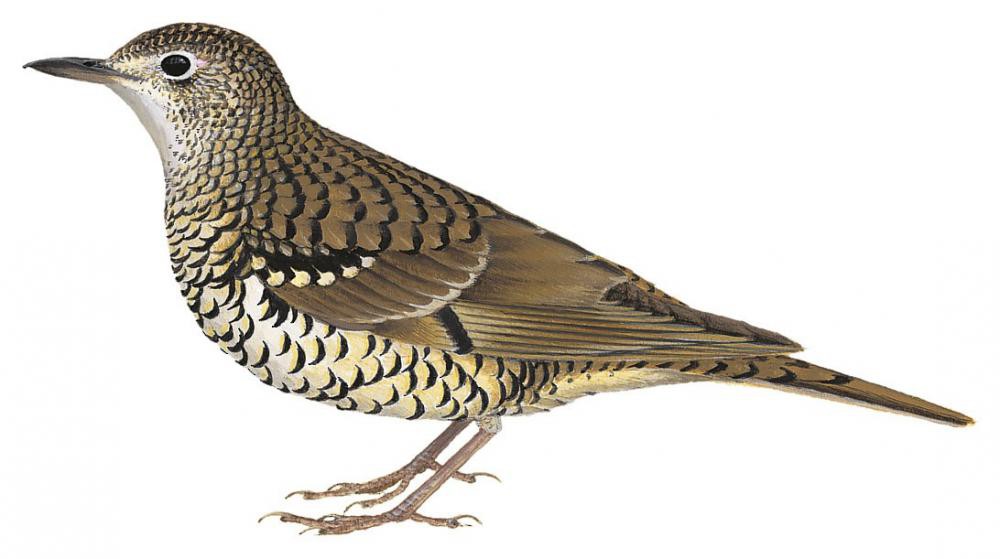Amami Thrush / Zoothera major

Amami Thrush
SCI Name:
Protonym: Geocichla major Annot.Zool.Jap. 5 p.178
Taxonomy: Passeriformes / Turdidae / Zoothera
Taxonomy Code: scathr6
Type Locality: Amami-0-Shima.
Author: Ogawa
Publish Year: 1905
IUCN Status: Near Threatened
DEFINITIONS
ZOOTHERA
(Turdidae; Ϯ Long-billed Thrush Z. monticola) Gr. ζωον zōon animal; -θηρας -thēras -hunter < θηραω thēraō to hunt < θηρ thēr, θηρος thēros beast, animal; "A species belonging apparently to the family of Merulidæ, and to that portion of it which, from their long legs and short wings and tails, indicate their station to be on the ground, afforded an opportunity of characterizing a form which seems hitherto to have been unnoticed. The length, strength, and arcuated culmen of the bill, and the length and strength of the hallux, formed the most distinguishing points of modification. ZOOTHERA*. Rostrum forte, elongatum, subcurvatum, subcompressum, culmine elevato; mandibula superiori subemarginata, dente subapicali vix decernenda; naribus ovalibus, lateralibus; rictu vibrissis rigidis munito. Alæ subbreves, subrotundatæ; remigibus prima brevi, secunda multo longiore, tertia quarta quintaque fere æqualibus longissimis, sexta his breviori at prima longiori, cæteris gradatim descrescentibus. Pedes subelongati, subfortes, acrotarsiis integris; digitis anterioribus subfortibus, externis ad basin membrana connexis, internis liberis, medio longissimo; halluce elongato fortissimo, ungue forti elongato. Cauda subbrevis, æqualis; rectricibus duodecim. ZOOTHERA MONTICOLA. ... * The group seems to have many characters in common with Pomatorhinus, Horsf. The strong and elevated bill constitutes the chief mark of separation. The alliance between the two groups may serve to indicate the general affinities of the latter genus, whose place in the system has been hitherto undetermined." (Vigors 1832); "Zoothera Vigors, 1832, Proc. [Comm. Sci. Corres.] Zool. Soc. London, p. 172. Type, by monotypy, Zoothera monticola Vigors." (Ripley in Peters, 1964, X, p. 144).
Synon. Aegithocichla, Andromedon, Cichlopasser, Myiophaga, Oreocincla.
major
L. maior, maioris greater, larger < comp. magnus great, large, powerful.
● ex “Poule d’eau de Cayenne” of d’Aubenton 1765-1781, pl. 352; “Even if [Statius Müller, 1776] ...should some day be repudiated by ornithologists on account of his carelessness and his apparent colour-blindness, then the proper name of the species would be Aramides major (Boddaert), founded on Daubenton’s plate” (Sharpe 1894) (syn. Aramides cajanea).
● ex “Grand Corbeau” of Levaillant 1800, pl. 51 (unident.;?Corvus sp.).
● ex “Crotophagus major” of Brisson 1760, “Grand bout de Petun” of d’Aubenton 1765-1781, pl. 102, fig. 1, “Ani des palétuviers” of Salerne 1767, and “Greater Ani” of Latham 1781 (Crotophaga).
● 54. PICUS. ... major. 10. P. albo nigroque varius, ano occipiteque rubro. Picus albo nigroque varius, rectricibus tribus lateralibus utrinque albescentibus. Fn. svec. 81. Picus varius major. Ges. av. 708. Aldr. ornith. l. 12. c. 32. Will. orn. 94. t. 21. Raj. av. 43. Alb. av. I. p. 19. t. 19. Frisch. av. . . t. 36. f. 1. Habitat in Europa." (Linnaeus 1758) (Dendrocopos).
● ex “Grande Egrette d’Amérique” of d’Aubenton, 1765-1781, pl. 925 (syn. Egretta garzetta).
● ex “Scolopax media” of Frisch 1733-1763, “Great Snipe” of Pennant 1768, and Latham 1785 (syn. Gallinago media).
● ex “Grand Indicateur, mâle” of Levaillant 1807, pl. 241, fig. 1 (syn. Indicator indicator).
● ex “Pie-grièche Blanchot” of Levaillant 1810, pl. 285 (syn. Malaconotus blanchoti).
● ex “An other sort of Loggerhead” of Sloane 1707-1725, “Sitta” or “Picus cinereus major, rostro curvo” of Ray 1713, “Grand Sittelle à bec crochu” of de Buffon 1770-1783, and “Great Nuthatch” of Latham 1781 (?syn. Myiarchus validus).
● ex “Parus major” of Gessner 1555, Belon 1555, Aldrovandus 1599, and Willughby 1676, “Fringillago”, “Great Titmouse” or “Ox Eye” of Ray 1713, and Albin 1731, and “Parus capite nigro, temporibus albis, nucha luteis” of Linnaeus 1746 (Parus).
● ex “Grèbe de Cayenne” of d’Aubenton 1765-1781, pl. 404, fig. 1, and “Grand Grèbe” of de Buffon 1770-1785 (Podiceps).
● ex “Barbican des côtes de Barbarie” of d’Aubenton 1765-1781, pl. 602 (syn. Pogonornis dubius).
● ex “Grande Quiscale” of Vieillot 1819 (Quiscalus).
● ex “Tangara des grands bois de Cayenne” of d’Aubenton 1765-1781, pl. 205 (syn. Saltator maximus).
● ex “Batara mayor” of de Azara 1802-1805, no. 211 (Taraba).
● ex “Macucagua” of Marcgrave 1648, Willughby 1676, and Ray 1713, “Perdix brasiliensis” of Brisson 1760, and “Magoua” of de Buffon 1770-1783 (Tinamus).
● ex “Trepadore grande” of de Azara 1802-1805, no. 241 (Xiphocolaptes).
UPPERCASE: current genus
Uppercase first letter: generic synonym
● and ● See: generic homonyms
lowercase: species and subspecies
●: early names, variants, mispellings
‡: extinct
†: type species
Gr.: ancient Greek
L.: Latin
<: derived from
syn: synonym of
/: separates historical and modern geographic names
ex: based on
TL: type locality
OD: original diagnosis (genus) or original description (species)












